I love curling up with a good dance book. If you do too, then this column is for you. This year, with more and more dance books coming out, I’ve narrowed down the type of books I include in this list. I tend to enjoy accounts of dance artists’ lives rather than books on a particular technique or a particular theory. I like the story part of dance history.
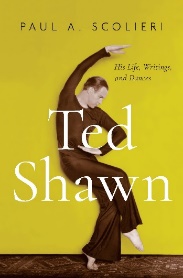 Ted Shawn: His Life, Writings, and Dances
Ted Shawn: His Life, Writings, and Dances
By Paul A. Scolieri
Oxford University Press
This book is epic. Paul Scolieri follows Ted Shawn’s life with wit and rigor, while also delving into the knotty issues surrounding dance, race, and sexual identity of those times. This is essential reading for anyone who wants to understand the rugged road to modern dance.
Ted Shawn (1891–1972) was a searcher and a builder. He searched for authenticity in dance and he built a foundation for modern dance. After a childhood marked by multiple tragedies, he dabbled in ballroom dance. He encountered the “chaste goddess” Ruth St. Denis, and together they shared a faith in dance as devotion. They formed Denishawn, the school and touring company that was the crucible of American modern dance. They were devoted to each other—at least professionally. In an early feminist gesture, she removed the word “obey” from their marriage vows. It was an open marriage before the term was coined, and the two had continual power struggles regarding their relationship as well as their careers.
Shawn was the first major male figure in American concert dance, and there was a certain amount of (necessary) narcissism in this. He unabashedly displayed his body as the ideal of white manhood. The writings of Havelock Ellis, who saw “inversion” (homosexuality) and art as harmonious, helped Shawn to envision his artistic next steps.
His interest in other cultures— Spain, India, Japan, China, Egypt—provided new material for dances and spectacles. He went on long pilgrimages, for instance to Algeria in search of Ouled Nial dancers, roughing it to find elements of dance that he could bring home to his American students and audiences.
The New York Times critic John Martin preferred the modernism of Shawn’s students, namely Martha Graham, Doris Humphrey, and Charles Weidman, to Shawn’s “romanticism.” In the balance of art and entertainment, one could conclude that Denishawn tipped more toward entertainment (Shawn and St. Denis were closer chronologically to vaudeville), while Graham and Humphrey tipped toward art. One could also conclude that Shawn exploited other cultures to cash in on exoticism at home. Both are at least partly true, but Scolieri portrays Shawn and his psychological struggles with sympathy while also noting his blind spots.
One dramatic/hilarious scene occurs when Shawn, who was always finding work for Martha Graham, was faced with the young dynamo making a scene in a restaurant, screaming at him that his teaching offer was beneath her as an artist. Next day, according to him, she came crawling back to beg forgiveness.
Thickening the plot were Shawn’s tortured bisexuality and his belief in eugenics. This was before the horrors of Nazism, when eugenics, originally aligned with art, health, and labor, twisted toward racism. But the racism had been a subterranean current all along. For Shawn, jazz was “poisonous,” and the melting pot of New York City was a “cesspool.” As Scolieri repeats these opinions, he verbally cringes along with his reader.
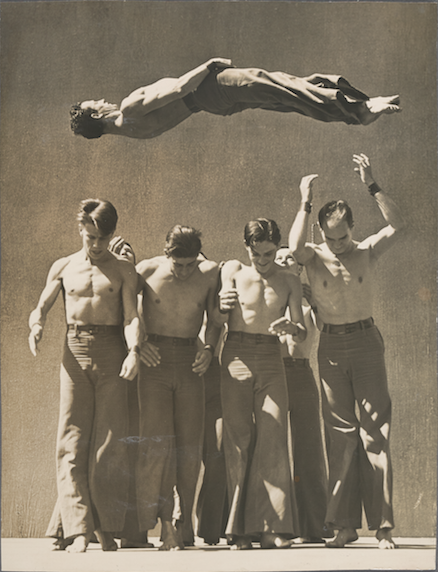
Kinetic Molpai (1935), photo by John Lindquist, Courtesy Houghton Library, Harvard University
After many long Denishawn tours (the tour of Asia was more than one year) and side collaborations (including with German expressionist Margareta Wallmann), Shawn bought the land that is now Jacob’s Pillow. There he developed perhaps his most fulfilling project: Ted Shawn and His Men Dancers. The group gave 1,250 performances in 750 cities and four countries. One of his most successful works was Kinetic Molpai (1935), which exemplified his vision of male muscularity and camaraderie within architectural formations. The Men Dancers was a glorious long finale of Shawn’s performing and choreographing life.
The marvel of this book is not only the revelation of how hard Ted Shawn worked and how embattled he felt. It’s also that Scolieri finds an eloquent balance between giving Shawn his due and pointing out his obliviousness to his white privilege.
Jacob’s Pillow Dance Festival is, of course, Ted Shawn’s most enduring legacy. That magnificent, constantly evolving dance mecca is only possible because of Shawn’s commitment, choreographic ability, courage, and leadership.
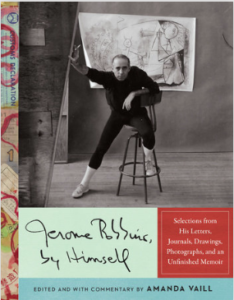 Jerome Robbins, by Himself
Jerome Robbins, by Himself
Selections from his letters, journals, drawings, photographs, and an unfinished memoir
Edited and with commentary by Amanda Vail
Alfred A. Knopf, Penguin Random House
There’s something delicious about reading Robbins’ account of himself and his life. We tune in to his desires, pleasures, plans, sorrows, and frustrations. His bright ideas are expressed modestly, his epiphanies promise inner peace. Whether rehearsals are going well or badly, he writes with the same intelligence and playfulness—and rawness—we see in his choreography.
Somehow, in between a myriad of choreographic projects, Robbins had time to write loving letters to his friends. To Donald Saddler, one of the original dancers at the start of Ballet Theatre (later ABT) who then joined the army in wartime, he writes often. He ends one letter with “My love to your mother and all your sisters.”
By all accounts, Robbins was difficult to work with: demanding and at times combative. This could be due to what he has called “heavy clouds of hot anxiety.”
Just before starting one of his greatest ballets, Dances at a Gathering (1969), he had an epiphany that “all mankind is related” through shared DNA. With this realization, he writes, “It seems to allow me to drop off my ego & my super defenses . . . I can begin to handle in contact, not in combat, people & places.”
In a 1967 letter, he articulates why he loves dance: “The province of Dance . . . evokes emotions and reactions not describable in words . . . it’s like the trip under the mushroom. One can come out of it and flounder, make metaphors about it, but one can’t truly pin it down.”
His letters to Tanaquil Le Clercq, the ballerina (and Balanchine’s wife) who was laid low by polio in 1956, are full of compassion, passion, longing, and fun. But those qualities burst through all the letters and notes here, revealing a man who loves life in the deepest ways.
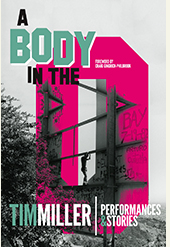 A Body in the O: Performances and Stories
A Body in the O: Performances and Stories
By Tim Miller
University of Wisconsin Press
When Tim Miller first performed at P. S. 122 in the early ’80s, he was a breath of fresh air—both kinds of fresh. He was agile, unpredictable, clever, and brash. He would spray paint the word “faggot” on his chest. (Actually, he could only fit F-A-G onto himself, and his partner at the time, John Bernd, penned G-O-T on his own chest, so you could get the whole word only when they stood together.) Another time, I remember Miller kissing Peter Rose through a sheet of glass. He was and is an activist performance artist who has toured internationally. In this slim volume, his stories, scripts, and reminiscences glide into one other.
The struggle against homophobia is Miller’s main topic, and his stories about growing up queer are feisty, piquant, and raunchy. He recounts how the explosion of feminist performance at Women’s Building in L. A. “encouraged my agency . . . and also made me want to be a lesbian when I grew up.” In 1990, he was one of the NEA Four, whose grants from the National Endowment for the Arts were rescinded because their work was deemed indecent. (They sued and won their case in 1993—but at a cost: The NEA dropped its grants to individuals.) An advocate for performance artists as “first responders,” Miller co-founded both P. S. 122 (now NY Performance Space) and Highways Performance Space in Santa Monica.
His stated mission: “I am in the business of trying to get light bulbs to go on over people’s heads. I am also trying be a gay first responder when the bomb threats get phoned in; I am trying to…defuse the bombs of bigotry and suspicion that keep our country paralyzed. And when someone comes up to me and tells me that a glimmer of change just happened for him, it’s like we just hit the jackpot; the lightbulb going on. The treasure of what this country might someday become pours at our feet.”
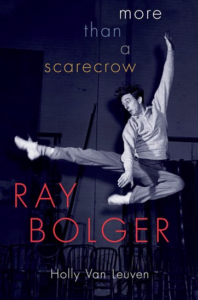 Ray Bolger: More Than a Scarecrow
Ray Bolger: More Than a Scarecrow
By Holly Van Leuven
Oxford University Press
Ray Bolger (1904–1987) was never as debonair as Fred Astaire or as crush-worthy as Gene Kelly. But he was a different kind of animal. He was an eccentric dancer, which meant he pushed everything to extremes—his limbs and his clownishness. The combination of stiff upper body and watery or jittery legs, his buoyant springiness and buckling spine—all this gave the illusion that he was out of control. But of course, every step was well rehearsed. In this clip from The Great Ziegfield (1936), his elegant tapping turns into staggering and lurching. One of his specialties was lowering into a split, drooping over in fatigue, then rising up by skooching his legs together. There simply was no one like him (though one can see echoes of him in Dick Van Dyke’s style.)
Of course, Bolger was his most lovable as the rubber-legged Scarecrow in “If I Only Had a Brain” in The Wizard of Oz (1939). But in this scene from the lesser known The Harvey Girls (1946), his goofiness is even more extreme.
In More Than a Scarecrow, Van Leuven explains, in dry but clear prose, how Bolger’s routine, which was in the legmania (or legomania) style of eccentric dance, was honed. He learned from predecessors in vaudeville like George Primrose, a white minstrel performer who traded steps with his black colleagues. He rose through vaudeville and early Broadway, largely due to his wife Gwen’s help in branding his act and getting gigs—even during the Depression.
In 1936 he originated the tap dance role in “Slaughter on Tenth Avenue” in the musical On Your Toes, working with choreographer George Balanchine. While he relied on the master for a dose of ballet discipline, Balanchine relied on Bolger for his knowledge of American music. A quote from the ballet master: “This Bolger [has]…an amazing relationship to the rhythm of the music. His muscles have like the sense of humor.”
During the grueling seven-month shoot of The Wizard of Oz, Bolger was touched by Judy Garland’s innocence, and they became lifelong friends.
But Bolger didn’t enjoy making movies. He felt the process was mechanical, lacking in honesty and spontaneity. “I have to be free,” he said. “That’s the difficult thing in the motion picture business—I felt I was dancing in a phone booth.” At the end of his life, he wrote an ode to dancers he admired, saying they “left a little on the floor.” That’s what he hoped would be said of him too.
Actually, a good chunk of “If I Only Had a Brain” was left on the cutting room floor. Just for fun, take a look at this deleted sequence—he soars high above the cornfields and crashes into the fence—on YouTube.
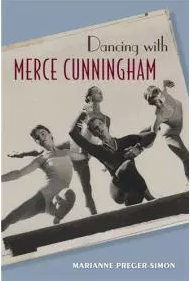 Dancing with Merce Cunningham
Dancing with Merce Cunningham
By Marianne Preger-Simon
University Press of Florida
In 1949, the sole student who showed up to Merce Cunningham’s first technique class was Marianne Preger. It was just her, Merce, and his snapping fingers. She started dancing with him before he formed his company in 1953 and continued until 1958, remaining friends with him until his death in 2009. This book emphasizes her social relationship with Cunningham rather than the artistic challenges. Compared to Carolyn Brown’s astute, epic work, Chance and Circumstance: Twenty Years with Cunningham and Cage, it is light, easy reading. Preger-Simon repeatedly calls his work “lovely” and “wonderful.” She comes across as having a naturally cheerful temperament, which was a salve for Cunningham, especially during stressful times. As Alastair Macaulay suggests in the afterword, Preger-Simon was the prototype for a string of such company members, being the “least psychologically needy one.” This is borne out by many passages in which Cunningham and Preger are hanging out together. One of the high points is the author’s account of a post-performance party at which Cunningham breaks into a tap dance.
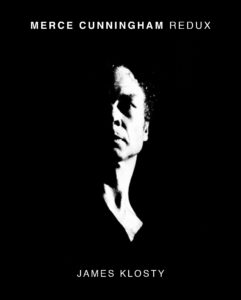 And while we’re on the subject of Merce…
And while we’re on the subject of Merce…
Merce Cunningham Redux
By James Klosty
PowerHouse Books
This exquisite book of mostly photographs focuses on my favorite period of the Merce Cunningham Dance Company: the late ’60s to early ’70s. I have put my excitement about this lavishly augmented version into this posting.
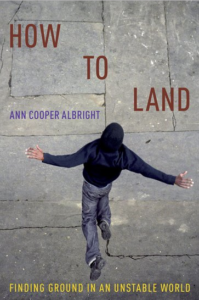 How to Land: Finding Ground in an Unstable World
How to Land: Finding Ground in an Unstable World
By Ann Cooper Albright
Oxford University Press
With her prodigious experience as a teacher of modern dance, a practitioner of Contact Improvisation, and a scholar of post-modern dance, Ann Cooper Albright lays out the connectivity between the experience of the body and the experience of the world. “Falls both literally and metaphorically knock us off our feet,” she asserts. She widens her meanings by comparing falling bodies to “falling buildings, falling planes, falling economies, falling governments.” Her students at Oberlin, she notes, are more agitated and less adventurous than previous generations, and she attributes this to post-9/11 and ensuing national disasters. But the book is prompted by a disaster of a more personal nature: the teenage nephew she was caring for plunged to his death during a daredevil dive. How to land is a poetic contemplation on the mind/body connection that helps us absorb such tragedies and move on.
Cooper Albright’s conviction “that there is a deep interconnectedness between how we think about the world and how we move through it” is supported in every part of the book. Dancers intuitively understand this, but Cooper Albright extends the idea to nondancers too. She posits three R’s of the body: responsiveness, resistance and resilience. Borrowing from Contact Improvisation and Body-Mind-Centering, she has come up with her own series of exercises to increase sensation and grounding. The chapters are arranged in a cycle: Falling, Disorientation, Suspension, Gravity, Resilience, and Connection. Each one riffs on a real experience in her own life. The chapter on disorientation, for example, begins with an account of being caught in a street protest in Athens when the police started unleashing tear gas.
Her imagination takes the reader into all kinds of insights. She envisions the skin as the screen door to the outside world. The body as home. How to Land accomplishes the wish of many artists: to be personal and universal at once.
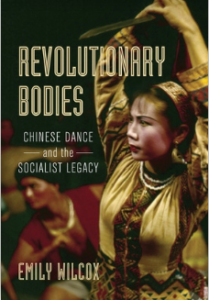 Revolutionary Bodies: Chinese Dance and the Socialist Legacy
Revolutionary Bodies: Chinese Dance and the Socialist Legacy
By Emily Wilcox
University of California Press
One of the few American dancers to have trained in China, Wilcox brings a fount of knowledge and experience to this book—not only of dance but of Chinese history in general. Contrary to the usual American narrative of Communist China shutting down individual artists’ work and producing propaganda ballets, Wilcox analyzes an array of Chinese 20th-century dance forms. She emphasizes the three founding principles of Chinese dance, as constructed by Trinidad-born choreographer Dai Ailian, who had trained in London: 1) kinesthetic nationalism (using movement from local sources), 2) spatial and ethnic inclusiveness (regarding minority ethnicities as good sources), and 3) dynamic inheritance (Chinese dance should draw on the past but also be new). Dai Ailian wanted the new aesthetic to be based on a merging of opposites: “northern and southern, secular and religious, elite and popular, rural and urban, Han [majority] and non-Han [equivalent of non-white].” In 1954, Dai became the first director of the Beijing Dance School.
Chinese opera, which combines music, words, movement, and acrobatic martial arts, was a rich resource in this project to construct a national dance form. Wilcox discusses other forms of dance that cropped up, like disco and hip hop. In the early 1980s, visits from Asian American dance artists Ruby Shang and Lan-Lan Wang were also influences. Wilcox tells us that Chinese dance today continues evolving through research and renewal.
While the author treads lightly on the repressiveness of Mao’s Cultural Revolution (1966–76), she does say that dance teachers were sent to do manual labor and that most forms of dance were banished during that period. But she also points out that women were given new respect. For example, marriage choice (as opposed to the tradition of arranged marriages) became a theme in the ballets of the period.
This book is the wave of the future in that it contains 19 QRs by which anyone with an iPhone can view video clips of the works she discusses. One fascinating example is the dance drama titled The Fires of Fury Are Burning (1964), performed by the PLA General Political Department Song and Dance Ensemble, about the brutality of American racism. It shows a community of people in blackface fighting a cruel white cop, complete with a burning cross and hooded KKK figures. In their naïve fashion—with exaggerated happy or angry facial expressions—this group was, according to Wilcox, “offering a message of support of African-American civil rights.”
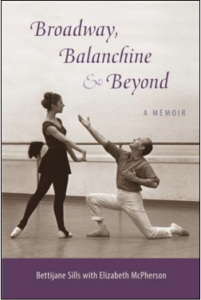 Broadway, Balanchine & Beyond: A Memoir
Broadway, Balanchine & Beyond: A Memoir
Bettijane Sills with Elizabeth McPherson
Foreword by Carol K. Walker
University Press of Florida
Bettijane Sills, who danced in New York City Ballet from 1961 to 1972, shares her perspective on Balanchine’s approach. His avoidance of divas, treating technique class more as a choreographic laboratory than as a time for the dancers to warm up, his love of gossip, his abhorrence of pretense, earn him the term, in the author’s words, “benevolent dictator.” Although Sills rose from corps to soloist, certain obstacles prevented her from rising to principal status. One of them was the emotional see-saw tied to her fluctuations of weight: Balanchine would reward her with good roles when she was thin and take them away when she gained a few pounds. Ostensibly the fat shaming wasn’t just to become thin, but to become expressive. “You are like a cocoon,” he would say. “Your true personality will only be revealed when all the fat is gone, and you are down to your bones.” In this #MeToo era, she felt compelled to say he never sexually harassed her, but then again, she was careful to keep her distance.
There are moments of humor, particularly in what the dancers said among themselves. For instance, one passage of Serenade where they repeatedly touch their foreheads is called the “aspirin dance.” After nine years in the company, plus marriage and a child, Sills started teaching. She’s been on the faculty of SUNY Purchase Conservatory of Dance since 1979.
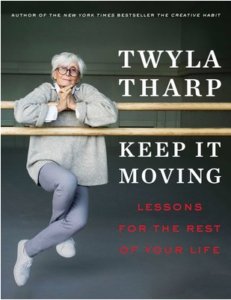 Keep It Moving: Lessons for the Rest of Your Life
Keep It Moving: Lessons for the Rest of Your Life
By Twyla Tharp
Simon & Schuster
Until her ’70s, Twyla Tharp never had a serious injury. She considered dance a “sacred trust, the fulfillment of my pledge to respect and work hard with what I had.” But after an injury that wouldn’t heal, she felt defeated. Being an uber problem solver, Tharp came up with strategies to get through the recovery process. This book is two books in one: First, a dancer’s story of injury, depression, and healing; and second, a how-to book for anyone who is facing aging. As with her books The Creative Habit and The Collaborative Habit, this one has grit because Tharp has figured all this out for herself. Here are some examples of her sensible advice: “Age is not the enemy. Stagnation is the enemy. Complacency is the enemy. Stasis is the enemy.” Here’s another: “Get out of your own way; do not expect what you have been in the past to make your today.” But enough of the don’t’s. Here are some inspiring Do’s: “Be deliberate, act with intention. Move. Chase the sublime and the absurd. Make each day one where you emerge, unlock, excite, and discover.”
Tharp also sets forth a number of exercises that could be done by nondancers as well as by dancers. My favorite is the Squirm, a movement she calls “our common evolutionary beginning.”
On her way to healing, the choreographer still retains her sense of wonder. For inspiration she watches an iPhone video of her grandson’s first steps, which reminds her “how incredibly courageous we all are as little mites lurching about in space.” And she’s thankful for the “freedom to be able to learn something for the second time around.” Of course, Tharp herself, still choreographing in her late ’70s, is an inspiration.
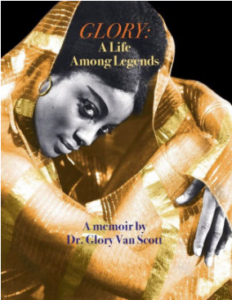 Glory: A Life Among Legends
Glory: A Life Among Legends
By Glory Van Scott
Self published, widely available online
Dancer, educator, producer Dr. Glory Van Scott grew up in Chicago with obvious talent as a dancer and singer. One of six children whose parents were a doctor and a model, she seemed to have a comfortable childhood. But in 1955, she learned that her cousin, Emmett Till, was murdered in Mississippi for possibly whistling at a white woman. At that moment she vowed not to succumb to violence and revenge, ever.
The legends she worked with include George Balanchine (in House of Flowers), Katherine Dunham, Agnes De Mille, Talley Beatty, Langston Hughes, and Miles Davis. Although Balanchine wanted her to dance in his company, she declined and went instead with Katherine Dunham. (Arthur Mitchell tells a great story about how he and Tanaquil Le Clerq tried to convince Van Scott to join New York City Ballet, but she not interested. (Go five minutes into this clip). She took on some roles that only Miss Dunham had done.
A charismatic performer, Van Scott danced in many musicals including House of Flowers, Finian’s Rainbow, Showboat, Porgy and Bess, A Funny Thing Happened on the Way to the Forum, Billy No Name, and Langston Hughes’s Prodigal Son. In 1978 she coordinated “The Magic of Katherine Dunham,” a historic series for the Alvin Ailey American Dance Theater. She also produced many children’s shows and memorial concerts for Miss Dunham, Syvilla Fort, and Talley Beatty. The current Dr. Glory’s Youth Theatre is still performing. In fact, Manhattan Borough President Gale Brewer’s office proclaimed December 1, 2019, “Dr. Glory’s Youth Theatre Appreciation Day.”
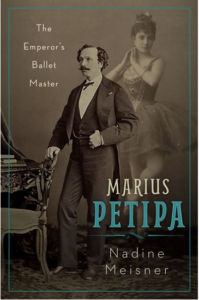 Marius Petipa, The Emperor’s Ballet Master
Marius Petipa, The Emperor’s Ballet Master
By Nadine Meisner
Oxford University Press
We tend to think of Marius Petipa (1818–1910) as ancient history. But he was the beginning of ballet as we know it. In this exhaustive study, Nadine Meisner emphasizes that Diaghilev’s Ballets Russes was built on the foundation that Petipa had laid. He oversaw the evolution from romanticism to the clean lines of classical ballet. In 1909, when Ballets Russes revived interest in ballet in Europe—only a year before Petipa’s death—it brought ballet full circle, since Petipa had started in France.
A member of a dancing family, Petipa came to St. Petersburg as a performer in 1847. He stayed on, excelling in character roles, for 22 years. From 1869 to 1904, as ballet master, he created ballets that Meisner calls “exciting yet refined.” He learned from his predecessors. For example, Perrot (creator of Giselle) was good at manipulating large numbers of people onstage, and Saint-Léon (creator of Coppelia) was good at making solos. Petipa made or re-made many ballets in addition to the ones he is most known for: The Sleeping Beauty (1890), Nutcracker (1892, for which he had more to do with the libretto than the choreography) and Swan Lake (1895).
As ballet master, Petipa was strict but well loved. In 1904, after he was replaced, some of the dancers—including Pavlova and Karsavina— signed a petition demanding that he be hired back. But the current directorate had no such plan.
Meisner doesn’t shy away from Petipa’s artistic weaknesses: Long processions interrupted the plot, the narrative was carried by mime instead of dancing, and the virtuoso steps did not match the story. She quotes a critic who called his first big ballet, The Pharoah’s Daughter (1862), “interminable.” But Petipa knew how to give the public the spectacles they wanted. Meisner contends that his choreography led to the reforms of Balanchine. “In the century’s final decade,” she writes, “the proportion of dance to drama increased in dance’s favour, opening the door to the plotless ballets of the twentieth century.”
I’ve written endorsements for two books, and I repeat them here:
Making Dances That Matter: Resources for Community Creativity
By Anna Halprin with Rachel Kaplan
Wesleyan University Press
Distributed by HFS Books
“Anna Halprin is a pioneer of postmodern dance, a warrior for connecting arts to social issues, and a healer of individuals and communities. Here, in crystal clear prose, her wisdom of the-body-in-the-world tumbles out. Borrowing concepts from various cultural traditions, Halprin lays out the scores she has created over a long lifetime of exploring and transgressing. Her ability to integrate body, mind, and spirit is both soothing and exhilarating.”
Drawing the Surface of Dance: A Biography in Charts
By Annie-B Parson
Wesleyan University Press
Distributed by HFS Books
“After a dance is gone, what traces are left? For Annie-B Parson, her drawings, charts, and observations of motifs provide a rich afterlife. She has created hundreds of these two-dimensional forms that challenge the ephemerality of dance. They depict the most tangible part of her dances: the objects that float in and out of her enigmatic collaborations with playwright/director Paul Lazar. They are clues to Parson’s fertile imagination. Gathered into Darwinian sets of sub-species, they take on an incantatory power.”
Other Books Received
Sonidos Negros: On the Blackness of Flamenco
By K. Meira Goldberg
Oxford University Press
One of New York’s great flamencas, Meira Goldberg (aka La Meira) has become a distinguished dancer/scholar. In this book, she finds the ideas of writers like Robert Farris Thompson and Toni Morrison “useful in cracking the carapace of flamenco’s weird stereotype” as the Other. She finds new wrinkles in the annals of blackface minstrelsy that pertain to gypsies. She writes about the “minstrelized Gitano, who carried a hybrid of Spanish and American representations of Blackness directly into flamenco.” The place of the soul in flamenco, according to Goldberg, is the “place of exile, the place at the heart of Spanish identity wherein lie “the Gypsy, the black, the Jew [and] the Moor.”
Out Loud, A Memoir
By Mark Morris with Wesley Spence
Penguin Random House
This review by Brian Seibert in The New York Times says it all.
La Meri and Her Life Dance: Performing the World
By Nancy Lee Chalfa Ruyter
University Press of Florida
La Meri (1899–1988), was known, in her day, as a remarkably versatile “ethnic dancer.” After studying Indian classical dance in India and flamenco in Spain, she toured with a wide-ranging repertoire throughout Europe, Asia, and Latin America. For many years she taught and performed at Jacob’s Pillow. This is the first biography of a woman who pioneered the form of what we now call “world dance.”
Staging Brazil: Choreographies of Capoeira
By Ana Paula Höfling
Wesleyan University Press
Distributed by HFS Books
In the 1830s, capoeira was a violent martial art. Opponents were described as “throwing themselves against each other like rams,” often ending in knife fights. In 1890, capoeira was prohibited from being practiced in public spaces. It eventually acquired more gymnastic and musical skills and was named “Brazil’s national sport.” Now that it’s a popular export, Höfling addresses questions like How much is still connected to the African diaspora? How pure are the rituals? Some feel that capoeira “magnified European audiences’ fantasies of a savage, wild, barely-under-control Afro-diasporic corporeality.” Höfling’s aim is “to untangle the notions of Africa, traditions, and the past” and look at the true complexity of capoeira today.
Physics and Dance
Emily Coates and Sarah Demers
Yale University Press
A beautifully written exploration into the interconnections between physics and dance, co-written by dance artist Emily Coates, who has worked closely with Jerome Robbins, Twyla Tharp, and Yvonne Rainer; and physicist Sarah Demers. Finding points of contact between how a dancer and a physicist look at motion, energy, time and space takes on a certain eloquence when the dancer is a thinker in her own right.
Celluloid Classicism: Early Tamil Cinema and the Making of Modern Bharatanatyam
By Hari Krishnan
Wesleyan University Press
Distributed by HFS Books
On the intersection and cross influence between film of South India and the evolution of the classical Indian dance form Bharatanatyam.
After the Arbitrary: Merce Cunningham, Chance Operations, and The Human Situation on Stage
By Carrie Noland
University of Chicago Press
This book de-emphasizes the role of chance in Cunningham’s choreographic process. According to the press release, Noland shows that the choreographer “enacted archetypal human dramas.”
Love, Icebox: Letters from John Cage to Merce Cunningham
Foreword, Commentary, and Afterword by Laura Kuhn
The John Cage Trust
Available at Artbook
Charming, casual, poetic notes about John Cage’s own composing process—and about falling in love with Merce. And gossip. One revelation is that Jerome Robbins wanted Cunningham for a lead in his musical On the Town. The letters get intense when Cage loses his equanimity, admitting to Merce that he needs to know if Merce feels the same way.
Featured 6
Hi Wendy, I love this list, and your comments. Thank you. Teaching dance history for 40 years has taught me so much, but there’s so much more to learn and to write about. Brava! Beth
Fringe, the new book on Maria Benitez, the “godmother of flamenco in New Mexico,” was published in 2019. It is a hardcover, coffee-table format book that includes nearly 200 photos by photographers such as Ruven Afanador, Ken Howard, Jack Mitchell, Beverly Gile, and Winter Prather. A photo of Maria by Jack Mitchell appeared on the cover of Dance Magazine in 1984, when Maria was the flamenco toast of Manhattan. She also choreographed and performed in Zeffirelli’s production of Carmen at the Metropolitan Opera House. Fringe is available from Amazon and can also be purchased from the publisher at bfishbine0@gmail.com.
Thank you, Brian.
Another new book that just came in: A Guru’s Journey: Pandit Chitresh Das and Indian Classical Dance in Diaspora, by Sarah Morelli, published by University of Illinois Press.
These are wonderfully, short yet incisive reviews that not only give a taste of what makes each of these books important in terms of their contribution to dance literature but also gently invite the reader to explore areas of dance that s/he might not otherwise be aware. Thank you.
Just read your comment about St Denis and Shawn being close to vaudeville and hence entertainers. Surely they used vaudeville for income. It did not control content. They performed in this medium ca 1916-22 at a time when vaudeville was open to inventive dance companies: notably, Marion Morgan’s, Alberta Rasch’s and Theodor Kosloff’s. You seem to driving a non-existent wedge between Denishawn and Graham.
I know very little about the three dance artists you mention, and I thank you for telling me about them. But I do know that Graham had a tempestuous relationship with Ted Shawn over time—and an intensely ambivalent relationship with vaudeville. One could even say that her distaste for vaudeville led us into modern dance as a concert form. Although she felt very connected to Ted Shawn and Ruth St. Denis, and she thrived in vaudeville in the early 20s, from appearing in both Shawn and Michio Ito’s work, she eventually broke away to create dance as art. Her temporary estrangement from Shawn is documented in Neil Baldwin’s book, Martha Graham: When Dance Became Modern, on pp. 74-75, and on p. 53 when she shrieks at Ted Shawn (“You cannot talk to me that way!”) and yanks a tablecloth, sending dishes clattering. Oh, it’s such fun to hear about her fury!